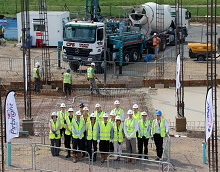



Construction Begins on Pirbright Avian Diseases Lab
UK - A concrete pouring ceremony has been held at The Pirbright Institute to mark the start of construction of new medium containment laboratories, which will be the home of the Avian Viral Diseases programme.Funded by UK Government via the Biotechnology and Biological Sciences Research Council (BBSRC), the £15.4-million building is part of a £250-million site redevelopment plan to turn The Pirbright Institute into the world’s most innovative and technologically advanced scientific centre for the study of viral diseases.

The state-of-the-art 3,500-square-metre laboratory facility will be used for in-vitro research at Containment Level 2 (CL2) and will support up to 90 scientists.
The Pirbright Institute’s Head of Estates, Dr Michael Johnson, who led the concrete pouring ceremony, said: “The building of the CL2 laboratory is critical to delivering the Institute’s one site science strategy, allowing our Avian Viral Diseases programme to move from Compton to Pirbright. We are confident that we will deliver an excellent facility that will retain and attract the world’s leading scientists.”
When completed, the new facility will house the Avian Viral Disease programme, which currently resides at the Institute’s Compton Laboratory site in Berkshire (scheduled to close in 2016). The CL2 labs will be used to research viral diseases that affect poultry, such as Marek’s Disease, infectious bronchitis virus and avian influenza, as well as low pathogenic viral diseases of other farm animals.
Professor John Fazakerley, Director of The Pirbright Institute, said: “This second phase of redevelopment will enable us to build on previous research and innovation successes in avian viral diseases, such as vaccines against Marek’s disease and the elimination of avian leukosis virus from poultry breeding stock. We will be able to expand our research into these and other important diseases of poultry as well as looking into diseases that can spread from poultry to humans, such as avian influenza virus.”
The CL2 laboratories will join the world-leading, high bio-containment laboratory complex which is currently being validated and will become operational late 2014. Together they will see the realisation of a single site with a variety of bio-containment level working environments to research viral diseases of poultry and livestock.









